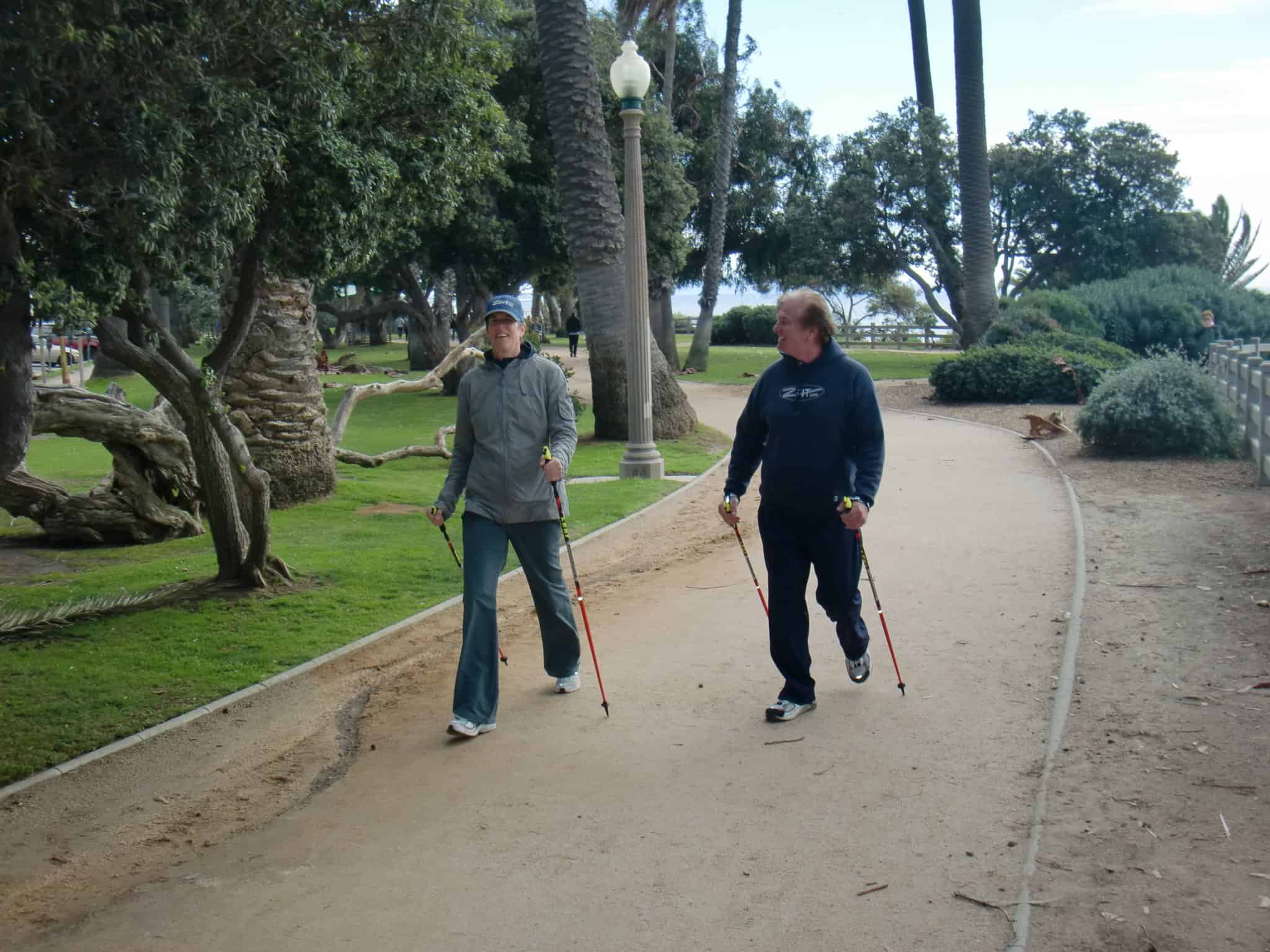by Patricia Staszak, PT
As temperatures here in Chicago start to rise, many of us are looking to ditch indoor gyms and take to the great outdoors for our regular exercise. Daily walking is an excellent, low-impact way to improve cardiovascular health and strengthen muscles and bones. But some of our patients find that pain or balance problems can prevent them from taking advantage of all what walking has to offer. If this situation sounds familiar, walking poles may be the solution for you. These handy tools provide a great way to keep many of us walking who would otherwise not be able to participate in this easy, weight-bearing exercise.
There are two main types of walking poles: trekking poles and Nordic poles. Trekking poles are primarily used for hiking and backpacking. They can help to decrease stress on the lower body and improve balance on uneven terrain. Trekking poles are available in different sizes, so you can find ones that work for your height. When sizing a pole for trekking, your elbow should be bent and your forearm should be parallel to the floor while gripping the pole. Trekking poles can be adjusted for effective support throughout your hike. Lengthen them when descending hills to improve the reach of the poles and reduce stress to the arms, and shorten them when going uphill to spread the increased workload throughout your body.
 Trekking Poles |  Nordic Poles |
Nordic walking, on the other hand, is a sport that can be done anywhere. Also known as “urban fitness walking,” Nordic walking relies on a specific walking technique in order to engage muscles throughout your body. A simplified description of this technique can be broken down into three main steps:
- While firmly gripping the pole and keeping your elbow straight, swing your first arm forward.
- Plant the pole onto the ground and use it to help propel your body forward.
- Stride through and relax your grip on the poles.
The combination of the continuous, rhythmic motion and the resistance created as the tips hit the ground makes this an excellent combination of strength and cardiovascular exercise. The upright positioning that is required for Nordic walking encourages your posture muscles to continuously engage and keep your joints in a neutral alignment. Developing the skills of this specific walking technique has many positive benefits for our bodies and can improve balance, agility, coordination, efficiency of movement and visual acuity. For additional instruction in proper Nordic walking technique, see this video.
Both methods of pole walking allow force to be absorbed by four points (two poles and both feet), rather than just two. This spreads the impact throughout the body and keeps any one joint from having to bear the brunt of the load—which can be very beneficial for those of us with pain in the ankles, knees or hips. In fact, a 1999 study in the Journal of Sports Medicine reported that using trekking poles reduces stress in the knees alone by 25%.

The poles and the feet contacting the ground provide a “four point gait” – meaning we have four points on the ground
Walking with poles is also great for anyone with balance problems. Physical therapists sometimes recommend them for patients with neurological deficits or elderly patients with weakness or trouble balancing. In these instances, poles can increase safety, help improve balance or even be the difference between being able to walk and not walking. For example, a patient with a walker who finds it difficult to go to a baseball game may find that it is easier to maneuver in the stadium with walking poles.
I first began walking with poles when worsening arthritic knee pain was preventing me from hiking or going on long walks. When I started using trekking poles to hike in the dunes, my knee barely bothered me. Today, walking with poles helps me pay attention to my gait. With every step I take, I can work on keeping my body centered and balanced—something we should all be striving for!
This article is meant as an introduction to walking with poles. If you are interested in starting a walking program, I recommend that you research the poles that best fit your needs. Remember, trekking poles are primarily used for hiking, so if you purchase them to use in the city, don’t forget to get rubber tips for the bottoms. For those interested in Nordic walking, I encourage you to learn more about the technique. Nordic Walking for Total Fitness by Suzanne Nottingham and Alexandra Jurasin is an excellent resource on this topic, and there are many videos on YouTube that explore the topic in-depth. And, of course, if you have any questions, feel free to contact us at Andersonville Physical Therapy.
RESOURCES
Carkonen, Shawn. “How to Choose Trekking Poles (and Hiking Staffs): Expert Advice from REI.” REI – Holiday Gifts, Outdoor Gear, Equipment and Clothing. Web. 30 Nov. 2010. <http://www.rei.com/expertadvice/articles/trekking poles hiking staffs.html>.
Nottingham, Suzanne, and Alexandra Jurasin. Nordic Walking for Total Fitness. Champaign, IL: Human Kinetics, 2010. Print.


Comments
I have been hearing quite a bit about urban walking poles.Will they help alleviate lower back pain? Where can I buy them so that I can be properly fitted? I live in Chicago.
Hi Lynn,
Thanks for your comment. We should suggest Nordic walking poles. You can purchase them online atLeki.com.